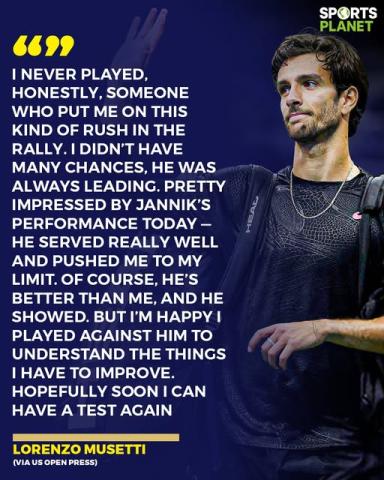
In the aftermath of a brutal straight-sets defeat at the US Open, Lorenzo Musetti offered something more valuable than an excuse: the unvarnished truth. His candid admission to the press wasn’t just a concession of defeat; it was a masterclass in identifying the very force that is reshaping modern tennis.
“I never played, honestly, someone who put me on this kind of rush in the rally. I didn't have many chances, he was always leading... He's better than me, and he showed. But I'm happy I played against him to understand the things I have to improve.”
This quote, from a talented top-20 player, is the most accurate diagnostic of the Jannik Sinner experience. Let's move beyond the scoreline and, with an expert's eye, break down what this "rush" means and why it makes Sinner nearly impossible to beat.
Deconstructing "The Rush": More Than Just Power
When Musetti says "rush," he’s not just talking about pace. He’s describing a comprehensive systemic breakdown caused by Sinner’s unique style. This rush is a multi-layered attack:
1. The Temporal Rush: Stealing Time
The foundational layer. Sinner takes the ball incredibly early, especially on the return of serve and on mid-court balls. This shaves precious milliseconds off his opponent's recovery time. What feels like a normal rally against anyone else becomes a frantic scramble against Sinner because the ball is coming back faster and from a position further inside the court. Musetti was constantly a half-step behind because the clock in his head was fundamentally wrong.
2. The Spatial Rush: Controlling Geometry
Because Sinner takes time away, he also controls the geometry of the court. By striking the ball on the rise, he flattens out the trajectory, keeping the ball low and skidding through the court. This prevents opponents from getting the ball up in their strike zone or moving forward. Musetti’s comment, “I didn't have many chances, he was always leading,” refers to this. Sinner dictates whether a point is played from the baseline, the mid-court, or at the net. The opponent has no choice but to follow.
3. The Psychological Rush: Forcing Errors
This is the culmination. The temporal and spatial rush creates a constant, low-grade panic. It forces players to go for too much from a defensive position or to over-hit in a desperate attempt to regain control. The opponent’s game plan disintegrates under the weight of perpetual pressure. They are not just being outplayed; they are being out-designed.
The Tools of the Trade: How Sinner Creates the Storm
Sinner’s "rush" isn't an accident; it's engineered through flawless technique and physical prowess.
-
The Serve: Once a weakness, it's now a weapon. His precise, powerful serving pushes opponents wide or pulls them off the court, immediately creating a weak return that he can attack. Musetti noted, “He served really well and pushed me to my limit.”
-
The Return: This is the trigger. Sinner stands exceptionally close to the baseline to return, even on big serves. This aggressive positioning is the first step in stealing time and seizing control of the rally from its very first shot.
-
The Groundstrokes: His forehand and backhand are pistons of pure, flat power. He doesn't just hit the ball hard; he drives it through the court with minimal loop, giving it that skidding, rushing quality that opponents hate.
The Expert Takeaway: A New Blueprint for Success
Musetti’s humility is revealing. “I’m happy I played against him to understand what I have to improve.” This statement acknowledges that Sinner represents a new benchmark. The old metrics of success—a big forehand, a solid backhand—are no longer enough. To compete with Sinner, the next generation must train for this specific "rush."
They must improve:
-
First-Step Explosiveness: To handle his early ball striking.
-
Decision-Making Under Duress: To avoid mental collapse.
-
The Ability to Create their Own Pace: To break his rhythm.
Jannik Sinner’s game is a brutal and beautiful evolution. He has synthesized the defensive resilience of the Djokovic era with the aggressive, first-strike firepower that defines the future. Lorenzo Musetti didn't just lose a match; he was given a glimpse into the future of tennis. And that future, for anyone standing across the net, is a relentless, overwhelming rush.
